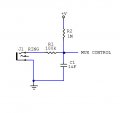I have a stereo input jack that is connected to the input of 2x opamp buffers (one each channel), this works fine as long as a stereo jack/signal is connected, but if a mono jack is connected, right channel is shorted to gnd by the plug, so you only get audio on the left channel.
What id like to do is somehow detect if a mono jack is inserted and connect the left output from the jack's tip connection to both channels.
Any ideas about how this can be done?
What id like to do is somehow detect if a mono jack is inserted and connect the left output from the jack's tip connection to both channels.
Any ideas about how this can be done?









